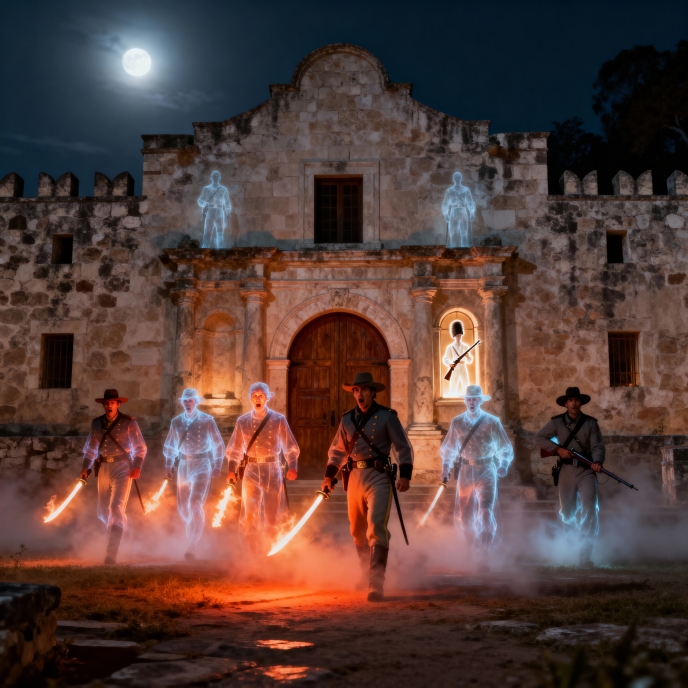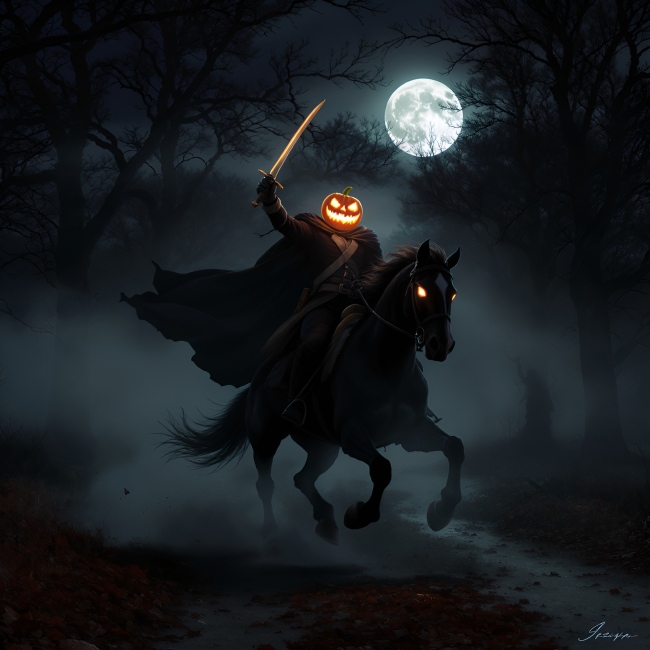
The image of spectral horsemen galloping across storm-dark skies has haunted human imagination for centuries. Known in various traditions as ghost riders, these phantom figures are often linked to themes of judgment, warning, and the eternal price of sin. While ghost rider tales appear in European and Native American folklore, the legend became most famous in the United States through cowboy ballads, Western ghost stories, and finally, the enduring song “(Ghost) Riders in the Sky.” This article explores the roots of ghost rider legends, their transformation in American folklore, and how one 1948 cowboy ballad immortalized the image for generations to come.
The idea of spectral horsemen can be traced back to the ancient Wild Hunt of Northern European folklore. Stories across Germany, Scandinavia, and the British Isles told of ghostly riders led by a mythic figure — sometimes Odin, sometimes a local king or spirit — sweeping through the skies on stormy nights. Those who witnessed the Hunt were said to face misfortune, death, or even be carried away into the other world.These stories often served as moral warnings: the riders were restless souls, doomed to ride forever for their sins in life, or a supernatural army punishing human wrongdoing.
When European folklore crossed the Atlantic, it mingled with the landscapes and traditions of the American frontier. Native American tribes had their own tales of spirit riders and cursed warriors who could be heard thundering across plains or deserts. As settlers spread westward, the cowboy era produced its own ghost stories. Drifters and ranch hands whispered of cowboys damned for cattle rustling, murder, or breaking sacred oaths, doomed to herd phantom cattle across the night sky. These stories were both chilling campfire entertainment and moral lessons, reminding listeners of the consequences of greed, cruelty, and lawlessness.
“(Ghost) Riders in the Sky”: The Song that Carried the Legend.
In 1948, songwriter Stan Jones, who had grown up in Arizona hearing cowboy and Native ghost tales, wrote “(Ghost) Riders in the Sky: A Cowboy Legend.” Inspired by the old stories, Jones wove a chilling narrative: A cowboy sees a vision of spectral riders chasing a herd of ghostly cattle across the sky. The doomed riders cry out, warning him to change his ways, lest he join them in their eternal punishment.

The song was first recorded by Burl Ives in 1949, but it quickly exploded in popularity with versions by Vaughn Monroe, Gene Autry, and Bing Crosby. Monroe’s recording became a No. 1 hit on the Billboard charts that year, cementing the song as one of the greatest Western ballads ever written.
“Ghost Riders in the Sky” became more than a song — it became a modern myth, blending old European folklore, Native American imagery, and cowboy storytelling into one unforgettable piece of Americana. Over the decades, the song has been recorded by Johnny Cash, Marty Robbins, Elvis Presley, Peggy Lee, The Outlaws, and even rock and metal bands, each giving it a new life.
Its themes — judgment, eternal punishment, and redemption — gave it resonance far beyond Western music. The ghostly riders became icons of both American folklore and popular culture, appearing in films, television, and even inspiring comic book characters like Marvel’s Ghost Rider. The enduring appeal of ghost riders lies in their symbolic weight. They embody: The wages of sin: The riders are cursed souls paying an eternal price.The warning vision: They appear to the living as omens, urging change before it’s too late. The frontier imagination: They tie together cowboy life, wild landscapes, and the human fascination with the supernatural. In essence, the legend of the ghost riders bridges the old world and the new: from Norse gods riding storm clouds to cowboys chasing phantom cattle across desert skies.
From ancient European tales of the Wild Hunt to the American ballad “(Ghost) Riders in the Sky,” the legend of spectral riders continues to capture the imagination. Part folklore, part morality tale, and part pop culture icon, ghost riders remain one of the most haunting figures of supernatural storytelling. The song ensured that these shadowy horsemen will never fade, but keep riding across stormy skies — forever warning us of the choices we make in life.
Marvel Comics’ Ghost Riders in the Sky: The Supernatural Bikers of the Marvel Universe
Few Marvel characters embody the mix of horror, Americana, and raw supernatural power as vividly as the Ghost Rider. While the flaming-skulled biker is most famously associated with Johnny Blaze, Marvel has developed an entire mythology around multiple Ghost Riders across different eras and realities. Among the most striking of these tales is the concept of the “Ghost Riders in the Sky”—a vision that draws directly from the iconic American cowboy ballad while re-imagining it through the lens of Marvel’s dark supernatural universe.
The phrase “Ghost Riders in the Sky” comes from the 1948 cowboy song written by Stan Jones, later popularized by Johnny Cash, Marty Robbins, and countless others. The song describes spectral cowboys chasing an endless herd of demonic cattle across the heavens, cursed for their sins on Earth. The imagery of damned riders galloping across fiery skies became a powerful piece of Americana folklore, merging the Western frontier with apocalyptic Christian imagery.
Marvel, ever adept at weaving myth, legend, and pop culture into its superhero worlds, took inspiration from this haunting vision when developing stories about the Ghost Rider legacy.
The Ghost Rider mantle has passed through many hosts in Marvel Comics, each bonded to a Spirit of Vengeance: Johnny Blaze (1972 debut) – The stunt motorcyclist who sold his soul to save his father, becoming the classic Ghost Rider.Danny Ketch (1990) – A Brooklyn native who discovered a mystical motorcycle and carried the flame for a new generation.Robbie Reyes (2014) – A young mechanic whose possession is tied to a demonic serial killer, blending street racing with urban horror. Kushala, the Demon Rider – A mystical Apache woman in the 19th century who merged Ghost Rider power with shamanic magic.
Beyond these individuals lies the revelation that the Spirit of Vengeance has existed for millennia, manifesting in different hosts across time—prehistoric mammoths, samurai, Wild West outlaws, and even cosmic beings.
Ghost Riders in the Sky – Marvel’s Interpretation: Marvel has explicitly referenced the idea of Ghost Riders in the Sky in its supernatural storytelling. Rather than a single cursed rider, there are times when legions of Ghost Riders have appeared, each burning with vengeance, riding together in unholy formations. “Spirits of Vengeance” (1990s and 2017 series): Both titles explored multiple Riders fighting side by side, echoing the imagery of spectral riders sweeping across battlefields. “Rise of the Midnight Sons” (1992): A crossover where Ghost Rider and other supernatural heroes united against demonic threats, evoking the same fiery riders-on-the-horizon atmosphere. Avengers #1,000,000 BC (2017): Introduced the prehistoric Ghost Rider, mounted on a flaming mammoth, as part of an ancient Avengers team. His eternal battle hints at countless Riders beyond time.Cosmic Ghost Rider (2018): Frank Castle (The Punisher) became a Ghost Rider infused with the Power Cosmic, literally riding across the stars, making the “riders in the sky” image galactic in scale.

When Ghost Riders assemble in the spirit world—or are glimpsed racing across the heavens—the connection to the ballad’s cursed riders becomes unmistakable. They are condemned, vengeful spirits, thundering through fire and brimstone skies, much like the cowboys of Stan Jones’ song. By tapping into “Ghost Riders in the Sky”, Marvel blends Western gothic horror with superhero storytelling. The Ghost Riders are: Modern Cowboys of Damnation – Trading horses for flaming motorcycles, they embody the wandering outlaw archetype. Punishers of the Guilty – Like the spectral cowboys chasing unending cattle, Marvel’s Riders pursue sinners across dimensions.
Mythic Archetypes – Each Rider reflects a different cultural moment: the stuntman craze of the 1970s, the gritty urban hero of the 1990s, and today’s fusion of heritage and cosmic power. In comics, the “Ghost Riders in the Sky” image functions both as a chilling visual and as a metaphor for the eternal cycle of vengeance—one that transcends time, culture, and even planets.
Conclusion
Marvel Comics has taken the haunting legend of Ghost Riders in the Sky and transformed it into a cornerstone of their supernatural mythos. From Johnny Blaze’s motorcycle tearing across desert highways to Frank Castle’s cosmic hellfire roaring through galaxies, each Rider adds to the eerie chorus of damned souls racing through eternity. Just as the original song warned of cowboys doomed to ride forever in the stormy night sky, Marvel’s Ghost Riders remind readers that vengeance never truly dies—it only changes its host, and keeps on riding.


